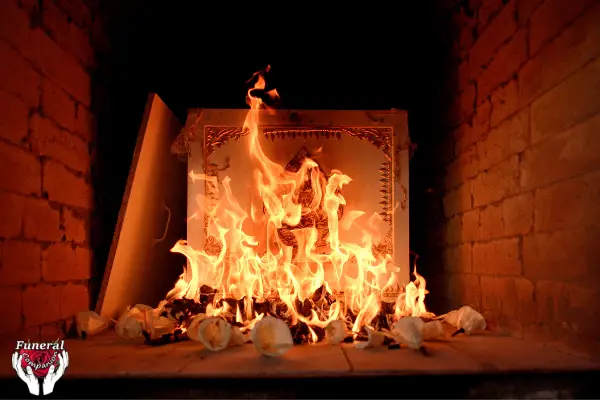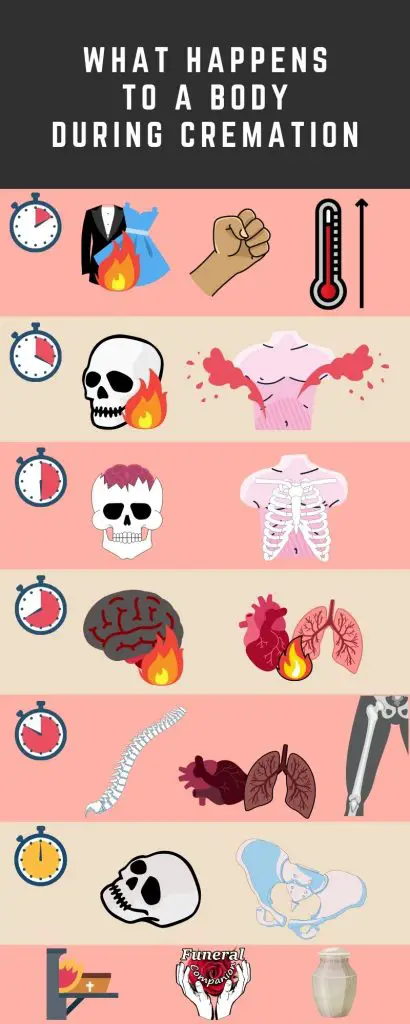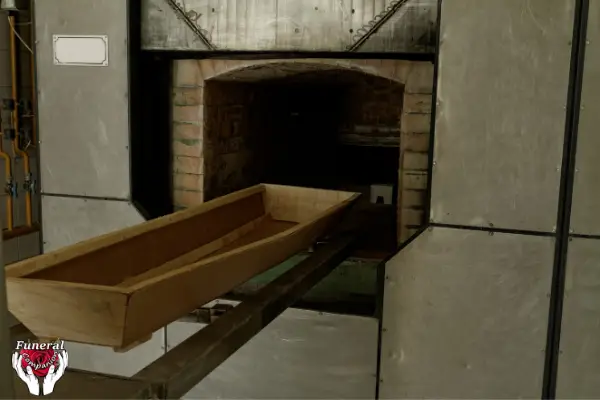When asked, most people would only be able to give the most basic description of what a cremation entails. We all know that this process reduces a body to ash, but there is actually a lot more to cremation than a simple fire.
If you are trying to decide between a burial or a cremation, then this article will go into a lot of detail about the latter. I will cover not only the official procedure but also exactly what happens to a body throughout the process.
Quickly though, in basic terms, what happens to a body during cremation?
A body undergoes intense heat (up to 2000°F) in a crematory which will reduce tissue to ash and fragment bones. Liquid within the body is vaporized and treated before entering the atmosphere. After a minimum of an hour, the remaining bones are removed and pulverized to form familiar cremated remains
So, with that general overview, let’s now get into detail about exactly what happens to a body as it goes through the process of cremation.
How do they prepare a body for cremation?

By the time a body arrives at a crematorium, it has gone through several processes already. A death certificate and permit to transport the body will have already been issued. Next, a funeral home will normally be the ones to collect the body and store it in cold refrigeration. If viewing has been requested, the body is normally embalmed although this isn’t a necessary process for direct cremations.
At the crematorium, the body will be taken to a special preparation room where it will at least be washed and dressed (depending on the requests of the family).
Jewelry is usually taken off and medical devices like pacemakers, prosthetics, or silicone implants are removed from the body. This is because pacemaker batteries can explode and prosthetics and breast implants melt, which would be to be scraped up.
When the body is dressed, it will then be placed in a casket of some description. Although casketless burials are possible, usually a basic cardboard casket is necessary for cremation.
Does the casket get burned with the body in a cremation?

If the body is placed in a casket for cremation, it will be burned with the body. This is something that many families perhaps don’t really think about when they are purchasing a funeral package.
Cremation-specific caskets are typically pine plywood or most commonly a cardboard alternative container. This is because they incinerate easily and are not that expensive.
However, most families don’t want to hold a viewing, a ceremony where loved ones say goodbye to the deceased, with a cheap casket on show. The simple solution here is to rent a casket for appearances and then have the body transferred into a more suitable and affordable coffin later.
It’s a lot more common than you might think and can save you thousands on the average price of a casket. If you need to reduce your costs, even more, I can highly recommend buying your casket directly from an online retailer and saving yourself even more money. See my recommendations here.
How do you know you have been given the right cremated remains?
The funeral industry, especially when it comes to cremations, has become very organized in tracking the dead. Many people fear that they are given a random person’s remains in an urn. This is VERY unlikely to happen.
Before a body is placed in a casket, and before it ever reaches a crematory, it is given an identity disk much like a dog tag. This will be put in with the corpse and stay with it from start to finish. So the remains can always be identifiable.
Once the cremation has taken place, the same metal disc is attached to the urn the cremains are placed in. Many crematoriums also include paperwork within the urn to further identify the person’s remains.
This has meant that when urns have been found by people buying homes from others, they have been able to track down the families through this paperwork.
What to expect when the cremation starts

In North America, cremations usually happen in specialized machines called crematories, but some older establishments also have brick-built versions. It’s impossible to have an old-style funeral pyre in the States, except for two places (Read my article on Viking funerals here).
Cremation of a body takes place in the first of two chambers, the primary chamber where the interior can reach temperatures of 1800 to 2000 degrees Fahrenheit, (900 degrees Celsius). In the Inferno, the soft tissues of the body, incinerate and vaporize, reducing to chunks of brittle bone and some ash.
An average cremation takes one to two hours, depending on the size of the person inside. During that one to two hours, about every 10 minutes or so the body will undergo some pretty intense changes on its way to complete cremation.
What happens to the body in the crematory?
Before a body is placed into a crematory, the ‘oven’ is preheated to 1500 degrees. Then the body is put into the first chamber with the aid of a special machine. This is because the crematory is dangerously hot and bodies can be heavy.

10 minutes into cremation
Within the first 10 minutes, all clothing will have been burned away, leaving the body exposed to the heat. Exposed to the flame, the muscles, skin, organs, and fat begin to sizzle and shrink.
If the body is incinerated before its muscle tissue has decomposed to any degree, the limbs may contract and the hands form a fist, the head may also tilt to one side. This has given rise to the myth that bodies sit up in the crematory. This simply doesn’t happen.
20 minutes into cremation
Most of the soft tissue has burned off of the face and skull except perhaps for the cheeks. The ribs will start to be exposed at this point. Through the chest and abdominal region, jets of liquid may spray from holes formed in the body. This is simply the moisture left in the body, aggressively evaporating. At about this point too the abdominal organs will dehydrate and start to shrink
30 minutes into cremation
The calvarial or skullcap will separate from the rest of the skull as boiling liquid pours from the fractures. The facial bones also have almost no tissue left on them.
The bones of the chest are all mostly exposed with the ribs either bending inward and outward. The vital organs of the abdomen continue to shrink and the arms and legs are mostly free of soft tissue. They may even be completely consumed by the flames at this point.
40 minutes into cremation
The calvarial has completely come off now exposing a blackened brain and the bones of the face have mostly disintegrated. The chest area is also mostly broken down, with twisted ribs which will have displaced most abdominal organs. These organs would now appear to be spongy black material, shrunken and burned. The lower parts of the arms would almost be burned away at this point in the process.
50 minutes into cremation
There would not be much left of the internal abdominal organs at this point, but if they are still intact they are certainly shriveled and look spongy. The legs would be nothing more than stumps ending at the thighs and the arms are mostly gone. The spinal column is more or less on its own now and is coming apart.
60 minutes into cremation
If the torso hasn’t already broken apart, it probably does that around the hour mark. You would expect the skull to be nothing but bone fragments. The internal organs are now reduced to ash and the pelvis has been consumed by flames.
While all of that tissue and bone is being burnt in the primary chamber of the crematory, the gasses, and particulate created by the cremation go into a secondary chamber where they are subjected to temperatures of around 1700 degrees Fahrenheit.
This second chamber is to reduce odor and emissions before they’re released into the atmosphere.
After cremation is completed
After the body has finished burning, the cremated remains are allowed to cool before they are swept by a crematory operator into a large tray. This is normally an integrated system, which means the staff doesn’t physically have to touch the bones at this time.
At this point, the remains are nothing but three to five pounds of fragile burned bone and some ash. This is not what you would recognize as cremated remains and you certainly couldn’t scatter these ashes yet.
Once the remains have been cleaned out of the crematory, they are taken to another area where they will be reduced to ash. A powerful magnet is run over the bones and ash to pick up any metal that made it through the cremation. This is normally in the form of surgical pins and similar items. These will later be recycled.
And then the cremated remains are ground into a powdery substance that you would recognize as cremated remains in, what’s called a cremulator from there, the cremated remains are placed in a container or urn for the cremated individuals, friends, or family to pick up.
How involved is the family at a cremation?

Families can be as involved in the process of cremation as they wish and as far as possible with the facility hosting them. While it is unheard of for a family to actually witness the physical incineration of their loved one, they can be present as it happens.
Some crematoriums will have the option of an attached viewing room which is separated from the crematory by a window. They can see their loved one being placed into the crematory by means of a body lifting machine called a retort.
In some instances, the families may be able to initiate the cremation process by means of a special button.
The level of a family’s involvement really depends on who they hire and the facilities available. If you are worried about having to witness a dead body or even smell something unpleasant, don’t worry. You never are forced to watch a cremation and the way the crematory is designed means that no bad odors can escape.
However, just like an open casket viewing or remaining at a graveside until the casket is lowered into it, the experience can be very rewarding and therapeutic for families. If you want to be move-involved, then make sure you ask about this possibility with the funeral home you hire.
How is a body put into a crematory?

The body, at this point usually in a casket, is placed in the crematory by means of a retort. This is a special body lifting machine that helps keep staff safe and the handling of the body respectful. Once the body is level with the door of the crematory, the staff can place the casket inside.
The cremator door opens and the casket is gently pushed into the preheated chamber because the chamber can be as much as 1500 °F / 800 °C. When the casket is loaded, it is not uncommon for the bottom of the casket to ignite before the loading arm has receded and the door is automatically closed.
If the casket used has a highly lacquered finish as many traditional caskets, do guests viewing the cremation may see a larger flash of flame. Once the casket is secured inside the chamber, the computerized system, which is continuously monitored by the operator, manages the process based on both the weight of the deceased and the type of casket used.
With the introduction of new technology, some crematoriums are very high-tech indeed. When applicable, the control system regulates the cremation to ensure optimum combustion, and a temperature of 1500 °F is maintained.
During this phase of the process, which can take between 70 and 150 minutes, all organic matter is consumed. What remains are bone fragments and any metal components such as orthopedic implants, the deceased may have had, or hardware from the interior of the casket.
The computer system will notify the operator when the cremation is complete. And after a visual check, the operator carefully collects the remains into a small hopper through access at the rear of the cremator. Once the remains have cooled for approximately 30 minutes, they are transferred to a cremulator
In high-tech setups, the cremulator is designed to automatically remove any remaining metal components from the bone. And ensure that they are reduced to a consistent texture, similar to grains of sand. This phase in the process takes approximately three minutes and when complete the remains or ashes as most referred to them are then transferred to an urn or container ready to be presented to the family.
How are remains removed from a crematory?

While there may have been some very advanced technological advancements in the process of cremation, some things are still manual. To remove the burned remains from a crematory, the staff have to use an assortment of long brushes to collect the remains in a special tray. Once these bone fragments and ash from body tissue are collected, they are then ‘mined’ for metal using a large heavy-duty magnet.
Once there are no foreign objects left, the remains are placed into a cremulator and crushed to produce cremated remains most people would think of as ‘ashes’.
Does the body feel pain during cremation?
The human body is not subjected to any pain during a normal cremation. Those cremated have normally been dead for at least 48 hours and medically are no longer responsive. Any movement within a crematory is purely a reaction to heat shrinking the body. Cremation is a painless practice.
It’s not uncommon for people to have a fear of cremation. Frankly, disposing of our bodies after death is an unpleasant thought and cremation certainly seems like a more violent and decisive practice than burial and natural decomposition. As far as modern science can guarantee it, and they are certain, there is no pain associated with cremation.
On a religious stance, it may be feared that the flames of a crematory symbolize too closely the flames of hell. If you are at all worried about the implication of cremation on your faith, please read my article on whether Christians and Jews should be cremated.
Do bodies explode during cremation?
The average body will not explode during the process of cremation, but evaporating liquid may violently escape a body as gas. In later stages of cremation, skulls can scatter in a violent way, which might sound like an explosion. Nevertheless, there is no danger of an entire body exploding at once.
Do you have clothes on when you are cremated?
A body can be dressed for a cremation in the same way it can be dressed for burial. This is entirely down to the discretion of the family. If desired, the deceased can be cremated in a simple garment or even totally naked. Dressing the dead is a service usually included in the price of cremation.
Do teeth burn in cremation?
Teeth, like other harder bone materials, may not be entirely burned during cremation. They will be made brittle by the high temperatures, which makes it easier to pulverize them later. All cremated remains pass through a special machine that breaks them down to ash which is given to the family.
This means that a family will never be handed an urn full of distinguishable bone fragments or teeth.
How many bodies are cremated at once?
Only one body will ever be cremated by funeral homes. This is because standard crematories don’t accommodate more than one corpse and it would make tracking individual bodies impossible. Even with direct cremation, only a single human is cremated.
If you would like more details about this question, feel free to read my in-depth article about how many bodies can be cremated at one time.



